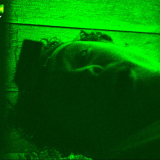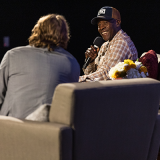Students Jump in to Explore Augmented and Virtual Reality
November 8, 2016
They ran into things. They got mugged. At least one person fell over a cliff. In some cases, the benefits of augmented reality don’t seem so wonderful.
While the crazy things that have happened to people chasing virtual monsters with their smart phones playing Pokemon Go has captured national media attention, an exploration of the possibilities of virtual and augmented reality has been steadily underway at Dodge College. Students and faculty in film, digital arts, production design, producing and gaming are working together to see what the future might hold.
From a 360-degree video of the Digital Media Arts Center on the web to a 360-degree live broadcast of the Dodge College commencement ceremony, students in the new Virtual Reality Club are experimenting with what’s possible. Meanwhile, the faculty have joined together in a Virtual Reality Task Force to create the Institute for Creative Reality, an incubator program dedicated to testing new and emerging technology in virtual and augmented reality.
“There’s a lot of enthusiasm around virtual and augmented reality right now,” says Associate Dean and Chief Technology Officer Dan Leonard. “We thought there was an opportunity for Chapman to be a thought leader in the area, not only to capitalize on the enthusiasm of today, but to set up an entity for all technologies that come tomorrow. That’s why we’re not focusing on augmented or virtual reality. Creative reality encompasses whatever comes down the turnpike in how we experience entertainment.”

Chapman isn’t alone in pushing into this new industry. Investors are pouring millions of dollars into research and development. In 2014, Facebook purchased Oculus VR for $2 billion. In 2015, Google invested $827 million in Magic Leap, an upstart dedicated to researching and creating virtual and augmented reality applications. By the end of the year, Apple, Google, and Facebook are expected to spend nearly $30 billion on research and development related to augmented and virtual reality.
“That was the kick start that the industry needed to push forward,” says alumnus Matthew Rebong (BFA/Creative Producing, ’15). “That allowed a lot of the tech developers to create amazing machines that wouldn’t have even been able to get funded even in the ‘90s.”
And Rebong should know. His company, Well Told Entertainment, is developing creative reality applications for story books, comic books, and various virtual reality devices. Since the company’s inception, it has benefitted enormously from this surge of investment from industry professionals.
“We are part of the Intel Developer Mesh program, which takes on developers and teams that are working on groundbreaking technology,” he says. “Through them, companies have been supplying us with equipment and hardware to develop software for devices like the HTC Vive and the Occulus Rift. Our vision is to be launch title creators on the AR technology that comes out in three to five years.”
Even with the recent investment and excitement surrounding creative reality, the industry still faces some serious challenges. One of the biggest is overcoming the limitations of the technology itself. With the Samsung Galaxy, for example, there are screen resolution issues—images can appear pixelated. It’s a challenge to change the sound that a virtual object makes depending on the viewer’s distance from it. Finally, there’s the vertigo and motion sickness some users experience when interacting with a virtual environment. “When people get sick,” says Sho Schrock (BFA/Creative Producing ’19), “it’s because the apparent motion on the headset is different than what is happening in the physical environment. When you accelerate or tilt the horizon line and it’s not doing that in real life, your brain experiences a disassociation between what you’re seeing and what you’re feeling.”

As Schrock knows full well in his role as producer of
The Harvest
, an immersive horror experience that Chapman students and alumni are creating, hardware and software limitations are just part of the problem. No one knows exactly how to tell stories in this new medium, where the director doesn’t totally control the narrative.
“In a lot of ways, it’s bridging different mediums,” says
Harvest
producer Bryce Cyrier (BFA/Creative Producing, ’18). “In some ways, it’s theatrical in that you have to be very rehearsed and it engages people in the same way as watching a staged show. In other ways, it’s still a cinematic environment, because everything is controlled. The technology, the video, the sound, it’s all new. There is no one way that people do things, because people haven’t done it for years. Trying to balance all of that and get the story right is a challenge.”
Sam Warner (BFA/Digital Arts ’15), CCO of Well Told Entertainment, agrees. “I was reading an article the other day talking about how the Solitaire game in Microsoft Windows was created to teach people how to use a mouse. We’re in a place right now where something like Pokemon Go is teaching people that augmented reality is fun, but it’s very simple in its implementation, because people are still learning how to use the technology. As things get more integrated and people adopt more and more complex pieces of augmented reality hardware – hardware that even has the potential to make screens and computers irrelevant – people are going to have to know how to interface with those devices. What we’re working on is primarily user experience: how do we give people literacy in augmented reality?”
“It’s a rare moment when you get to be part of building the language and experiment,” says Roy Finch, one of the professors on Dodge College’s Virtual Reality Task Force. “The language of cinema is 80 to 90 years old. Things haven’t changed much. Editing is faster, but most of it was figured out very early on.
“Now there’s this new thing and nobody knows anything,” he says. “How cool is that? How rare is that? It’s a rare opportunity to be part of something that’s just beginning. I’m interested in experimenting with these new storytelling mediums and helping students figure out how they work.”
EDITOR’S NOTE: This article originally appeared in the Fall 2016 issue of In Production. Read other great articles, and catch up on older issues, by clicking here.
Also, want to know more about Virtual Reality at Dodge College? Soon, we will release the first episode of the Dodge Cast, the official podcast of Dodge College. Keep an eye (or ear!) out for it, as the initial episode is all about VR!


